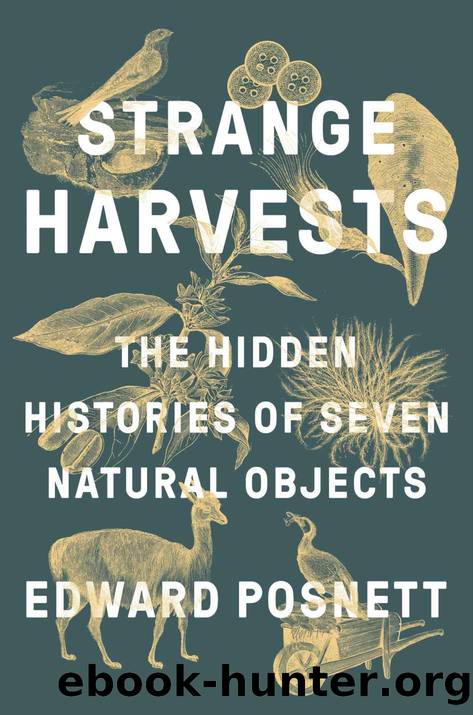Strange Harvests by Edward Posnett

Author:Edward Posnett [Posnett, Edward]
Language: eng
Format: azw3
Publisher: Penguin Publishing Group
Published: 2019-08-05T16:00:00+00:00
* * *
—
There’s a detail in the history of the conquest, the story of how fewer than two hundred Spaniards subdued the Incan Empire, that has always intrigued me. In the period before the Spaniards execute Atahualpa, the Incan emperor, Pedro Pizarro notices his attire, a dark brown cloak as soft as silk. Intrigued, Pizarro, then a teenager, asks Atahualpa about the material of which it is made. According to Pizarro, Atahualpa replies that it is made of the skins of vampire bats, harvested in Puerto Viejo and Tumbez, two northern provinces within his empire. “Those dogs of Tumbez and Puerto Viejo,” Atahualpa reportedly says, “what else have they to do than to capture these animals so as to make clothes for my father?”
When the Spanish penetrated into Incan territory, they came across huge warehouses piled with goods. They contained items of great value and utility—food, arms, ornaments, and tools—but the Spanish were most startled to find vast quantities of wool, cotton, cloth, and garments. “There was so much cloth of wool and cotton,” wrote Francisco Xérez on seeing a warehouse in Cajamarca, “that it seemed to me that many ships could have been filled with them.” Faced with the abundance of cloth, stored as if it were treasure, the Spanish were reduced to a state of speechlessness. “I could not say about the warehouses I saw, of cloth and all kinds of garments which were made and used in this kingdom, as there was no time to see it, nor sense to understand so many things,” wrote Pedro Pizarro.
It is not hard to grasp why Pizarro was so bewildered by the abundance of cloth in the Incan Empire. The Spanish came to South America in search of gold, looting temples and fortresses, but they found an empire that was held together by fiber. “There is nothing strange in the use of prestige objects,” writes historian John Murra, “the novelty consists in discovering that, in the Andean area, the artefact of greatest prestige and thus the most useful in power relations was cloth.” Skilled weavers, the Incas relied on cloth for countless functions, from sacrificial offerings to burials. According to Murra, “No political, military, social, or religious event was complete without textiles being volunteered or bestowed, burned, exchanged, or sacrificed.”
The Jesuit Bernabé Cobo related that the Incas had two types of fabric: awasqa, a rough, thick cloth for domestic purposes, and kumpi, a finer fabric that was described as being as soft as silk. But the most coveted materials were those that were wild harvested, often reserved for elites. According to Garcilaso de la Vega, the Incas harvested vicuña fiber in a chaku, a practice in which the animals were live-shorn. He wrote that the Incas’ hunting party would assemble twenty to thirty thousand people to form an enormous circle around thousands of wild animals. After closing in on them, male vicuñas and guanacos (the large cousin of the vicuña) were killed, but females were shorn and freed. The roundups
Download
This site does not store any files on its server. We only index and link to content provided by other sites. Please contact the content providers to delete copyright contents if any and email us, we'll remove relevant links or contents immediately.
International Integration of the Brazilian Economy by Elias C. Grivoyannis(70467)
The Radium Girls by Kate Moore(11569)
Turbulence by E. J. Noyes(7664)
Nudge - Improving Decisions about Health, Wealth, and Happiness by Thaler Sunstein(7198)
The Black Swan by Nassim Nicholas Taleb(6724)
Rich Dad Poor Dad by Robert T. Kiyosaki(6113)
Pioneering Portfolio Management by David F. Swensen(6039)
Man-made Catastrophes and Risk Information Concealment by Dmitry Chernov & Didier Sornette(5596)
Zero to One by Peter Thiel(5448)
Secrecy World by Jake Bernstein(4345)
Millionaire: The Philanderer, Gambler, and Duelist Who Invented Modern Finance by Janet Gleeson(4051)
The Age of Surveillance Capitalism by Shoshana Zuboff(3958)
Skin in the Game by Nassim Nicholas Taleb(3944)
The Money Culture by Michael Lewis(3795)
Bullshit Jobs by David Graeber(3792)
Skin in the Game: Hidden Asymmetries in Daily Life by Nassim Nicholas Taleb(3698)
The Dhandho Investor by Mohnish Pabrai(3538)
The Wisdom of Finance by Mihir Desai(3498)
Blockchain Basics by Daniel Drescher(3297)
